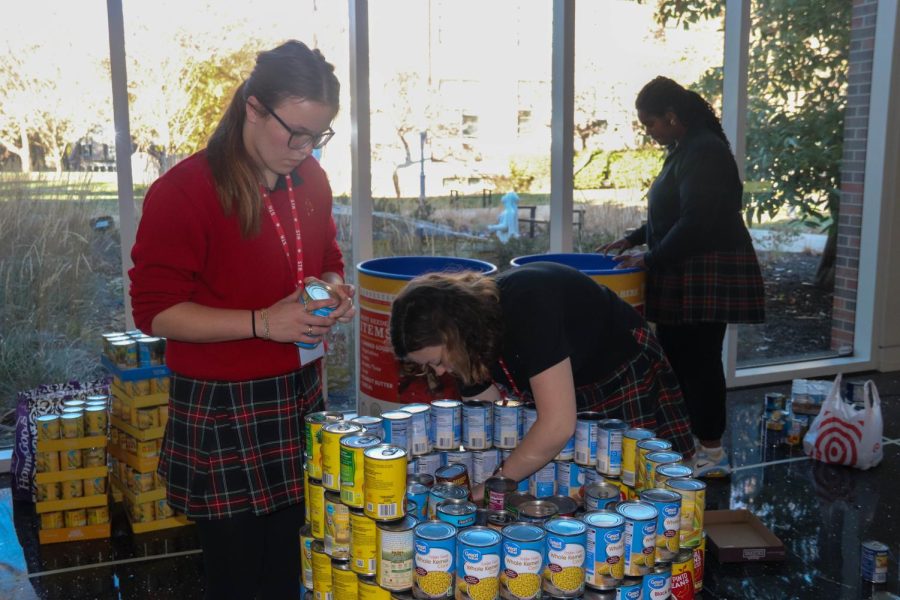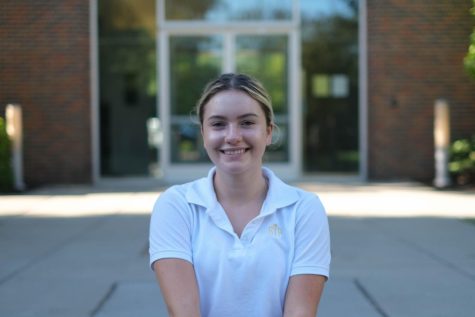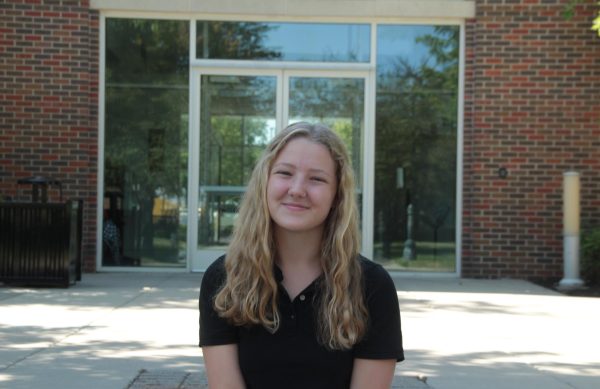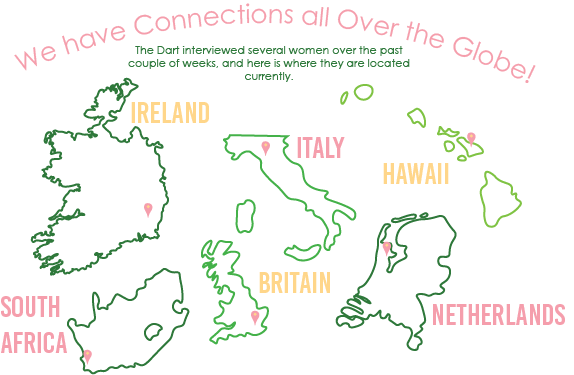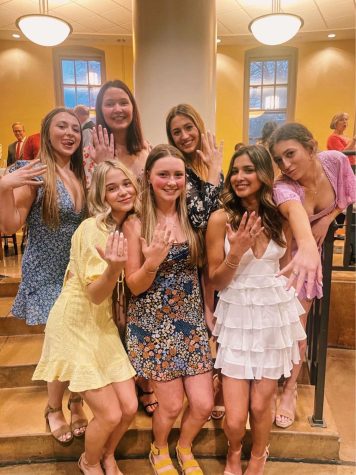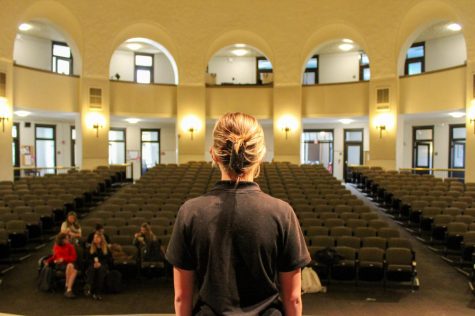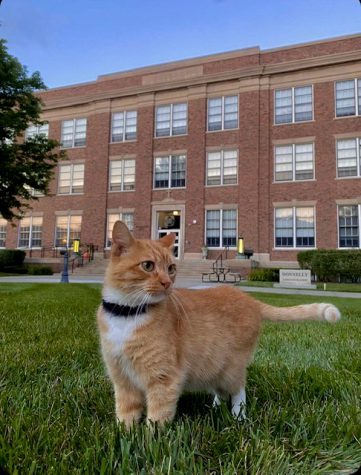CAN We Do It?
With the CANstruction drive ending in November, questions about service and how to maximize its impact on the “dear neighbor” are examined.
Seniors Connell and Lucy Fanning place cans in the structure.
December 9, 2022
Yellow and blue cans lined the entrances of the Goppert and Windmoor Centers on Nov 21 as students methodically placed each can in its predetermined spot. This fall, STA students built two “Despicable Me” minion structures out of cans donated over a month-long period. This process followed the rules and regulations of CANstruction, a non-profit organization that serves to address food insecurity by building structures out of cans. Director of STEAM projects and education Mandi Sonnenberg was introduced to the CANstruction organization and wanted to use it as a tool to motivate STA students into bringing cans—which are donated to Harvesters at the end of the process. Last year, STA’s Student Government picked up the project and students collected over 2,100 cans and built two structures: a pie and Christmas lights. Senior Jillian Poplau, STA Student Government leader, has held a big part in contributing towards CANstruction this year. Poplau, other members of Student Government and CANstruction leadership coordinators: seniors Liz Connell, Riley Carlson, Lucy Fanning helped brainstorm incentives, manage money and collect donations for the drive. “[CANstruction is] Student Government’s sponsored drive for the year; we always do a service project,” Poplau said. “We originally did the winter clothing drive for Morning Glory, [but] this year we’re doing CANstruction again.” As STA’s CANstruction does not compete against any other schools, Student Government attempted to spark student initiative by pitting building groups against each other. Illustrated by STA’s mission of “lov[ing] the dear neighbor without distinction,” service is a key aspect of being a student at STA. Seniors and juniors are required to attain 65 hours in order to graduate and within the 35 clubs and 49 extracurriculars, each is allowed one school-sponsored fundraiser per semester. Several clubs and extracurriculars at STA center solely on providing service to the greater Kansas City community, one of which is G.I.V.E. (Get Involved, Value Everyone). Senior Stella Hughes, president of the extracurricular, plays a key role in organizing service opportunities for students to attend. “[G.I.V.E’s] goal is to foster a love of service for the students beyond just the required hours that you need to get done,” Hughes said. “[We want] students to leave STA and continue doing service wherever they end up.” G.I.V.E. works with several organizations in the Kansas City area, such as Lead to Read KC and Operation Breakthrough, and they recently held a dog adoption event. The organization encourages community outreach and emphasizes the importance of empathy in service through both events organized with the school and opportunities in the Kansas City area provided to members. Hughes seeks to use these to open students’ eyes to the benefits of service. “I think it really connects you well with people who don’t have the same experiences as you. If you have the resources and the privilege to help someone, you should,” Hughes said. G.I.V.E. also serves for some as an opportunity to build long-term relationships with organizations. “[I think] reaching out and forming your own personal connections with agencies is super important,” Hughes said. “You can build a community with them, and when you consistently volunteer at one place you can get to know people really well.” As G.I.V.E.’s volunteers are students, they have many constraints on their time, and may struggle to fit service into their busy schedules. Hughes, as a member of the student body, also has to navigate these obstacles, and offers advice to fellow STA students. “[Service is] not as much of a consistent thing as I’d like it to be because of how busy I am, but I think whenever you have free time, try and fit something in even if it’s small,” Hughes said. Other STA organizations support individual charities through fundraisers, drives or bake sales. This semester, 17 club or extracurricular-sanctioned fundraisers in various forms have taken place. There have been fundraisers through Pizza 51 and Culvers, a movie night for FBLA, clothing/hygiene drives and three bake sales. In a survey of 50 STA students, 88 percent said that bake sales attract student participation and money, while only 12 percent said that drives—like CANstruction—were effective fundraisers. This year, Sonnenberg and the Student Government noted a decrease in participation. In the same survey of 50 students, half said that they had not donated to CANstruction in any form this year. Sonnenberg attributed it to all of the service projects occurring simultaneously during the second quarter. “I think there’s just a lot of different calls for service going on,” Sonnenberg said. “I know clubs are trying to raise money and I know in the bylaws it says each club could have one fundraising event. Everyone’s just trying to raise money [during this time] and so I think that can cause some saturation.” Sophomore Maddie Torrey agreed that there were good intentions behind the drive, but also remarked on a lack of motivation. “CANstruction is definitely good for the school, [but] I don’t really think that it’s been effective this year. Bringing cans in, especially when you’re in high school, you just forget,” Torrey said. Torrey suggested that the school explore other, more motivating, drives in place of CANstruction. “I really don’t feel like people are contributing to [CANstruction] as much because they don’t really think that it’s that important. The winter coat drive I feel like always does better because then people feel like ‘Oh, I have a winter coat’. But cans you always have to go out and get or you have to bring in money for it. I don’t think that people take it as seriously as the other ones,” Torrey said. Sonnenberg suggested an alternate solution, focusing instead on shifting the time of the drive. “Maybe we move CANstruction, so it’s not during the auction…maybe we move it to the spring,” Sonnenberg said. Sonnenberg also presented solutions related to crowd-sourcing ways to improve the drive. “I feel like [we need to ask] the students, ‘What’s gonna motivate you? What would be helpful?’” Sonnenberg said. Poplau has also noticed the lack of active participation and enthusiasm with CANstruction during this year’s drive. “I think people see [buying cans] as kind of a hindrance to have to go out and physically buy the cans and they don’t see that they are getting much in return,” Poplau said. “Incentives do help people participate more, but I don’t think people should only be doing service because they are getting something in return.” In the student survey, 68 percent marked their required STA service hours as a motivator to serve; students also reported that they were motivated by personal incentive. Although underclassmen do not have required service hours for STA, Torrey participates in service due to both personal fulfillment and a desire to help those in her community. “It always makes me feel really good when I’m able to help people and contribute something to people around me,” Torrey said. “Thinking about all the people who have helped me in my life to get to where I am today, I want to be able to help someone else in their life as well.” Torrey has participated in many service opportunities both inside of STA and in the wider community, but reflected on one she felt passionate about: Noah’s Bandage Project. The project is a drive which collects band aids to help children who deal with cancer. “[This project] definitely sticks out to me because it’s not something that you just sign up for,” Torrey said. “It’s something that you put together because you know the people. It gives you an inside view.” Similarly, Hughes has felt intrinsically motivated to do service inside of STA through G.I.V.E., as well as outside of STA. “I have been blessed with resources and opportunities that other people my age that live not even five blocks away from me don’t have,” Hughes said. “If I have those resources, and that privilege, then I like to be able to use it to help other people.”



